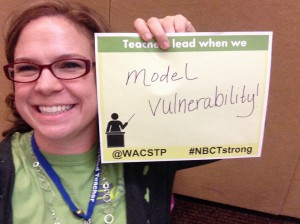Recently a teacher came to my room asking for advice. She had a little girl reading well above grade level, and she wanted to know how she could address her needs. We talked about options, and I shared some of the materials I use. She left feeling like she could better meet the needs of her exceptional student.
I teach fifth graders in a self-contained class for highly-capable students. My kids are bused to me from all over my district. Teachers in my school come to me for advice, but teachers in other elementary schools in the district do not have a HC teacher in their building as a resource. It’s not as easy for them to get help.
When I first arrived in this state in 1989, having a program for gifted students was optional for districts. The state had a pot of money set aside for gifted education. Districts that opted to offer a program could design a program that suited their needs—focusing on grades three through eight, for example—and then access state money.
These state funds, by the way, did not cover the cost of the program my district offered. My district ponied up the rest of the money.
Then a couple of years ago the state made Highly Capable part of Basic Education. Now every district is required to have a program for HC students. The program must run K-12. And according to McCleary, local levy money can’t be used for Basic Education.
Oh, yeah. The pot of money the state kicks in hasn’t really changed much over the years.
Wait a minute!
- The participating districts have gone from voluntary (around half) to all required to have programs. Many are building programs from scratch.
- The participating grade levels at each district have gone from some selected grade levels to all grade levels, K-12. I believe that’s an increase for every district in the state!
- And after McCleary, districts can’t use local levy money to shore up any missing dollars.
Obviously, the districts need more money for quality programs to meet the needs of their Highly Capable students.
I’m on the executive board of WAETAG (Washington Association of Educators of Talented and Gifted). We saw this change in the law coming and realized teachers would need training. We worked with Whitworth College to train a cadre of WAETAG teachers as professional development staff to work with ESDs and districts to offer classes in Nature and Needs of Gifted, Differentiation, Critical Thinking, and Creative Thinking.
Attending those classes is, of course, voluntary.
Teachers who have HC students in their classroom need to be trained in HC students’ special needs and in how to meet those needs. It’s not fair to place HC students in a teacher’s classroom and tell the teacher to meet their needs without that training. (Most teacher training programs do very little preparation in terms of HC education. My original certification program in the 1970s? I think it had about a paragraph!)
I’m glad HC students are recognized as Basic Education students. I think they need targeted funding that meets their special needs. I think the legislature needs to fully fund both HC students as well as the professional development of their teachers.
![By Christine Zenino from Chicago, US [CC BY 2.0 (http://creativecommons.org/licenses/by/2.0)], via Wikimedia Commons](https://storiesfromschool.org/wp-content/uploads/2014/12/800px-Venice_Fireworks_New_Years_Eve_5334256947-240x240.jpg)





